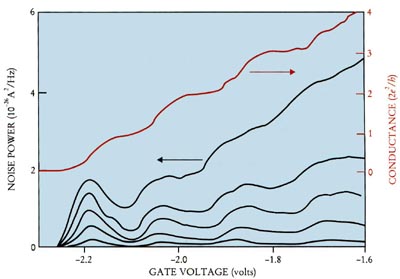The electrical current through a point contact is not constant in time, but fluctuates. The conductance determines only the time-averaged current. The noise powerat frequency
is the Fourier transform of the correlator of the time-dependent fluctuations
in the current at a given voltage V and temperature T. One distinguishes equilibrium thermal noise (V=0,
) and non-equilibrium shot noise (
, T=0). Both types of noise have a white power spectrum (i.e. the noise power does not depend on frequency over a very wide frequency range). Thermal noise is directly related to the conductance through the fluctuation-dissipation theorem (
). Therefore, the thermal noise of a quantum point contact does not give any new information.
Shot noise is more interesting, because it contains information on the temporal correlation of the electrons which is not contained in the conductance. Maximal shot noise (
) is observed when the stream of electrons is fully uncorrelated. A typical example is a tunnel diode. Correlations reduce P below
. One source of correlations, operative even for non-interacting electrons, is the Pauli principle, which forbids multiple occupation of the same single-particle state. A typical example is a ballistic point contact in a metal, where P=0 because the stream of electrons is completely correlated by the Pauli principle in the absence of impurity scattering.

Figure 6. Periodic suppression of the shot-noise power of a quantum point contact, measured with an applied voltage of 0.5, 1, 1.5, 2, and 3 mV. (Adapted from ref. [23].)
A quantum point contact in a 2D electron gas has a different behavior. Using a Landauer-type formula (see sidebar), Gordey Lesovik (Moscow) has predicted peaks in the shot noise at the steps in the conductance [22]. The peak height
is half the maximal value for uncorrelated electrons. The shot noise vanishes in between the steps. Michael Reznikov and collaborators from the Weizmann Institute in Israel have recently presented a convincing demonstration of this quantum-size effect in the shot noise [23]. (See figure 6.) By going to microwave frequencies (8-18 GHz) they could avoid the ubiquituous "1/f noise" at lower frequencies.